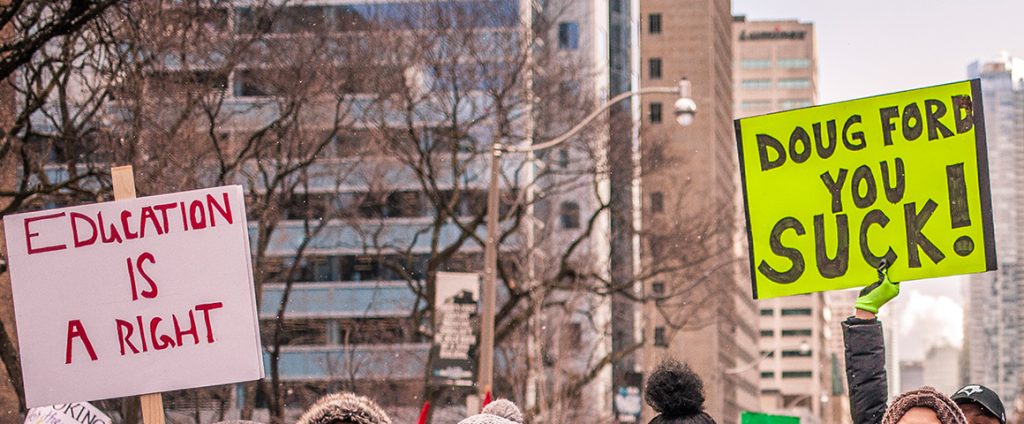PV Ontario Bureau
If you read, and trust, the mainstream corporate media, the Ontario government’s March 15 announcement that it will loosen restrictions on class sized is a straightforward change that will align Ontario schools with those in the rest of Canada. There will, the story goes, be no loss of jobs for currently employed teachers and little if any impact on students’ classroom experience. Current class sizes are based on an average student-to-teacher ratio of 22:1, and the government intends to change that to 28:1 in the provincial budget due in April.
“Sure,” say the Tories, “we’d all like our kids to have classes of 22 or fewer, but it’s a perk that Ontario’s deficit just can’t afford any longer. Besides, we’re only adding 6 students and that’s only in high school.” Sounds like good old common sense.
Except, that’s not the whole story.
Class sizes are established by local collective agreements, so they technically can’t be changed by the provincial government. What the Tories are doing is setting a new ratio for the average class size used to calculate funding.
It’s a bit confusing, but it works something like this: the provincial government provides funding to school boards largely on the basis of enrollment, and the dollar figure is calculated according to a student-to-teacher ratio. Currently, the ratio is 22:1, applied to the average enrollment across the entire board. The province provides the calculated funding to local boards, who then prepare their annual budgets and provide funds to individual schools. That local school funding is used to cover salaries for teachers and other education workers, whose numbers are calculated according to class sizes that are locally bargained.
Changing the student-to-teacher ratio can have a tremendous impact on school funding, even if the formula itself remains unchanged. Moving from a 22:1 ratio to 28:1 amounts to a 20% reduction in the resultant enrollment-based funding grants. So, a “modest” increase in average class size is actually a massive funding cut.
But wait, it gets worse.
The government has also said that high school students will have to take 4 of their 30 credits through online courses. Here again, the proposal sounds reasonable – technology has enabled more and more research, education and work to happen through online collaboration, so why not introduce students to that milieu in a deliberate way?
Well, here again, we don’t have the full story.
While the Tories continue to talk about a 28:1 student-to-teacher ratio, the online credits will be used to effectively change that ratio to 35:1. This is because online courses can accommodate scores, or even hundreds, of students. The enrollment-based funding grants for these courses – which constitute 13% of high school students’ credits – will be 35% lower than the current ones.
The Ontario Secondary School Teachers Federation (OSSTF) calculates that these changes will result in over $700 million in funding cuts to public education, and a loss of over 24% of current classes from the public school system. While the government has repeated that no currently employed teacher will lose their job, these funding cuts are expected to result in 10,000 fewer teaching positions across the province over four years.
And the bad news still doesn’t stop.
The provincial government is expected to deliver the online learning through a centralized entity, instead of through local boards. This raises the question of what entity will actually be tapped with this task, since no appropriate public structure currently exists. In all likelihood, the government will grant this work to a private organization, and thereby privatize a huge section of public education.
Doug Ford’s class size changes are truly a Trojan horse for funding cuts to public education.

All of this raises the question of resistance. Clearly, a united front of teachers, education workers, students and parents is necessary to push back such a profound attack from such an aggressive government. Students are planning a province-wide walkout on April 4. Teachers’ and education unions warn that they will fight these cuts by all available means.
But, effectively countering the Ford government also requires alternative policies that are based on working class demands. Unions and progressives have long called for Ontario’s enrollment-based education funding to be replaced by needs-based funding, that would recognize the particular challenges faced by specific students, schools and communities, and guarantee adequate funding to meet those needs.
Another policy that is key to progressive public school reform is for a single, secular public school system with French- and English-language boards. This is the most direct immediate path to ensure well-funded, democratic and accessible public education in Ontario. In part, this means ending the practice of privatization – including through the sale of school lands, outsourcing specific programs and services to the private sector, or introducing corporate management techniques that drive public schools to emulate private schools. But this also means ending public funding for Catholic schools and merging them into a secular system. And herein lies a second Trojan horse, one that threatens to undermine the unity of the resistance.
Time and again, Catholic teachers’ unions have committed to a united struggle with their public counterparts against government policies. But invariably, they have been bought off by the promise of extended funding to Catholic schools. Unity has been broken, and the struggle to defend public education has been betrayed.
In the current struggle, the stakes are far too high for such fickle and sectarian approaches. If Ford is to be confronted and forced down, teachers, education workers, students and parents have to find a way to advance progressive policies and win a majority of the working class to those positions. Where one component in the struggle is bought off through its own sectarianism, the others will need to be strongly supported by an engaged public, to continue the fight.
UPCOMING EVENTS IN TORONTO
On April 4th students at more than 500 schools across Ontario will be participating in walkouts against education cuts. Students organizers estimate 100,000 students will be participating in school walkouts. Parents of elementary students, let’s step up! If you can, take the afternoon off work. Sign your kid/s out of school early and explain you are participating in walkouts against education cuts. Join parents at your school or at a neighbourhood meet up to rally against education cuts.
Families with pre-k kids please join a neighbourhood rally!
In the Toronto west End: Intersection of Bloor and Dufferin





